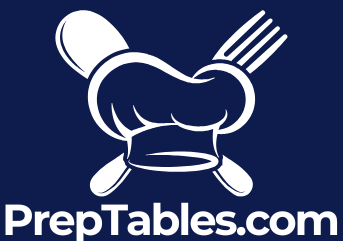
Ultimate Guide to Water Filtration Systems for Restaurants
Share
When you run a restaurant, you obsess over ingredients. But what about the one you use in everything from coffee and soda to pasta and soup? A proper water filtration system for restaurants isn't just a piece of plumbing; it's a core ingredient that shapes flavor, consistency, and even your bottom line. It's the silent partner ensuring every dish and drink tastes exactly right while protecting your expensive equipment from an early grave.
Why Water Quality Is Your Restaurant's Secret Ingredient
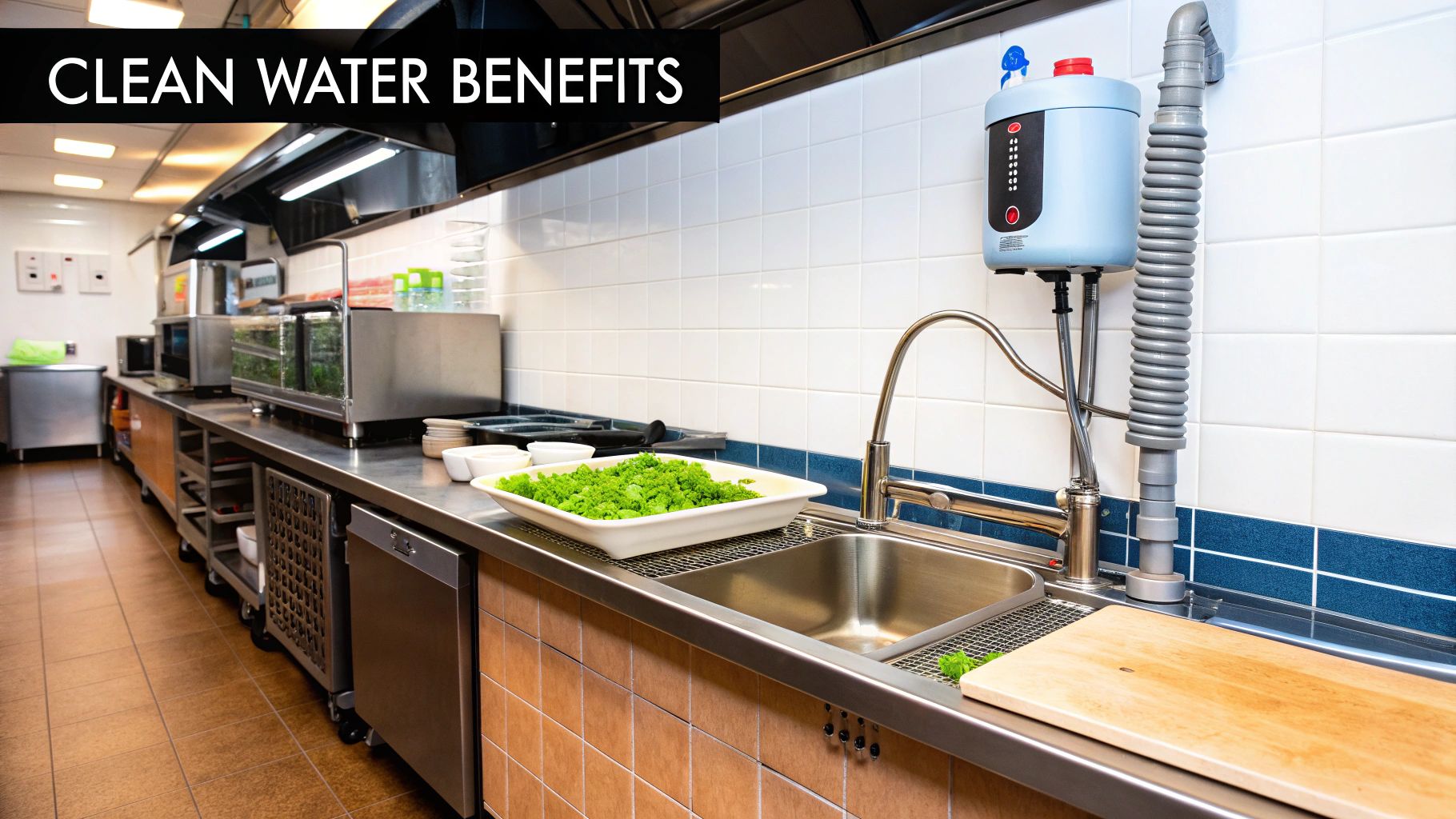
Think about the water flowing through your kitchen. It's not just for cleaning. It's a fundamental part of almost every single item on your menu. From the water that brews your morning coffee to the ice that chills a happy-hour cocktail, its quality leaves a lasting mark on your customers.
Unfiltered tap water is never just H2O. It carries a slew of invisible hitchhikers—chlorine, sediment, and minerals—that can throw off tastes and aromas in ways you might not even notice at first.
This is exactly why a professional water filtration system for restaurants is so non-negotiable. It's the gatekeeper that strips out all those unwanted impurities before they ever touch your food or drinks. The result? A consistently clean, pure base that lets the true flavors of your carefully sourced ingredients take center stage.
Elevating the Customer Experience
You'll see—and taste—the difference immediately. Let’s look at a few everyday examples:
- Beverages: Ever had a fountain soda with a faint "swimming pool" aftertaste? That's chlorine. It can also make coffee and tea taste harsh or bitter. Filtered water gets rid of that chemical note, leaving you with crisp, clean-tasting drinks every time.
- Ice Quality: Hard water, full of minerals, makes for cloudy, soft ice. Not only does it look unappealing, but it melts faster and can leave a chalky taste behind. Filtration gives you crystal-clear, solid ice cubes that chill drinks properly without watering them down.
- Food Preparation: The water you cook with matters. Excess minerals can mess with the texture of dough in your baked goods. Chlorine can get absorbed by pasta or vegetables as they boil, subtly changing their flavor.
Protecting Your Essential Equipment
Beyond just taste, a good filtration system acts as a bodyguard for your most valuable kitchen assets. The biggest villain here is limescale, which comes from minerals like calcium and magnesium found in hard water.
Limescale is the silent killer of water-fed equipment. It forces machines to work harder, consume more energy, and ultimately fail prematurely, leading to expensive repairs and disruptive downtime.
This crusty, damaging scale builds up inside your coffee makers, ice machines, steamers, and dishwashers, causing all sorts of headaches. By filtering out these minerals from the start, you stop scale in its tracks, helping your equipment last longer and run the way it's supposed to.
It's no surprise the industry is catching on. The global commercial water filtration system market is on track to hit around $6.14 billion by 2025, largely because more and more food service businesses understand these benefits. You can find out more about the commercial water filter market growth and what's driving it.
Understanding Commercial Water Filtration Technologies
Choosing a water filtration system for your restaurant can feel overwhelming. You’ll hear terms like "reverse osmosis" and "activated carbon," and it's easy to get lost in the jargon. But these concepts are simpler than they sound, and each one solves a specific problem in your kitchen.
Think of it like building a specialized kitchen team. You wouldn’t ask your star pastry chef to work the grill line, right? In the same way, you can't expect one type of filter to handle every water issue. The secret is to match the right technology to the right job, whether that's brewing the perfect cup of coffee or protecting your expensive combi oven from scale buildup.
Sediment Filters: The Bouncer
First, let's talk about sediment filters. These are the unsung heroes of any filtration system. Picture them as the bouncers at the front door of your restaurant's water supply. Their one job is to stop the big, obvious troublemakers—like dirt, rust, sand, and silt—from getting in.
These larger particles might not seem like a big deal, but they can wreak havoc on your plumbing and equipment over time. They clog pipes, wear down seals on faucets, and can badly damage the sensitive internal parts of ice machines and coffee makers. A sediment filter catches this debris first, protecting the rest of your system so the more specialized filters can do their jobs. It's your essential first line of defense.
The chart below shows just how many different contaminants are in typical tap water compared to safe standards, which is exactly what these filtration systems are designed to combat.
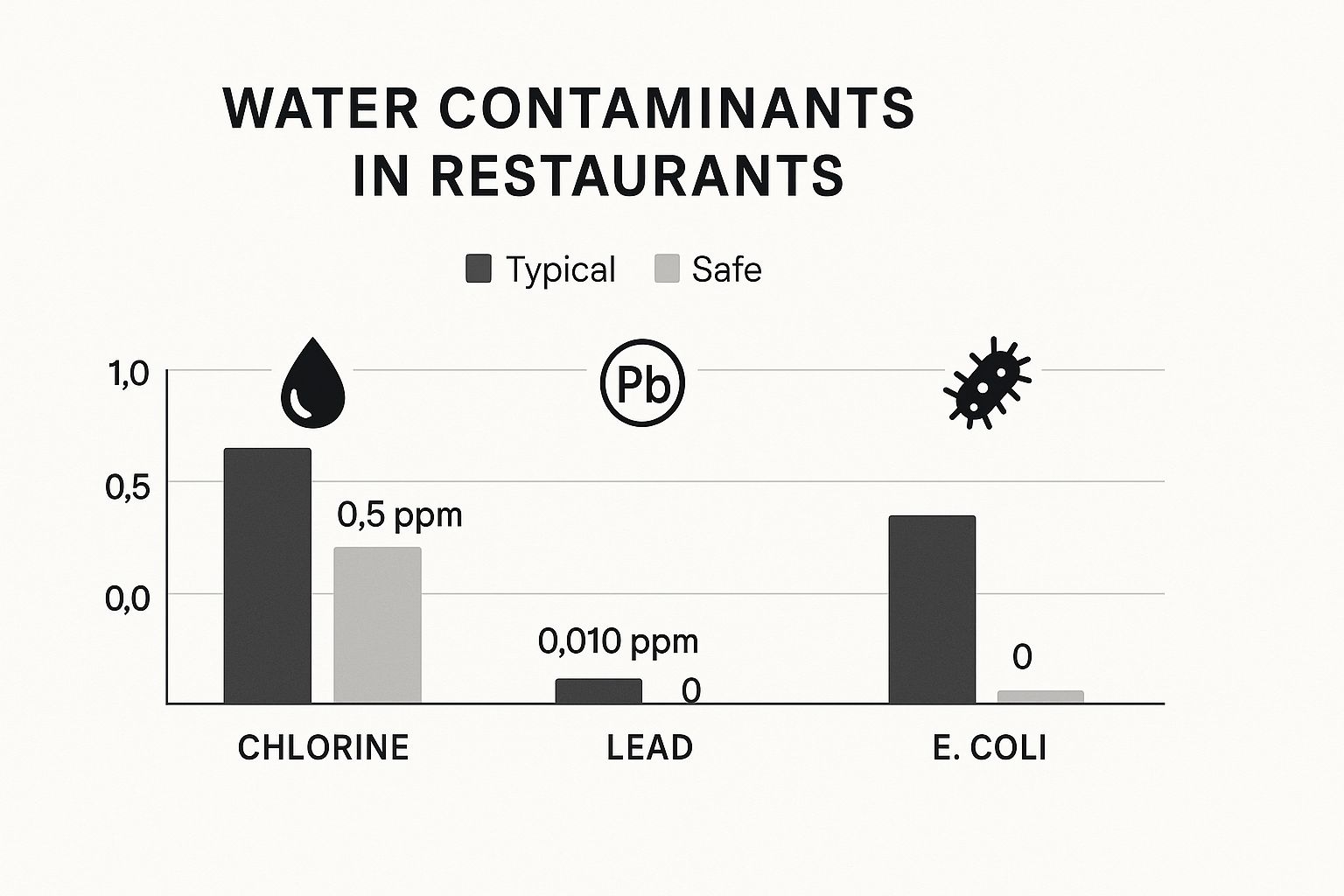
This visual makes it clear why a multi-stage system is so critical for a restaurant. No single filter can effectively tackle such a wide range of impurities on its own.
Activated Carbon Filters: The Sponge
Next up are activated carbon filters. The best way to think of these is as a powerful sponge for your water. The carbon inside is treated to create millions of tiny pores, which gives it a massive surface area. As water passes through, these pores trap and absorb chemical impurities, especially chlorine and chloramines.
This is a game-changer for taste and odor. Chlorine, which cities use to disinfect the water supply, is the number one enemy of great-tasting beverages. It’s what gives tap water that distinct chemical flavor that can completely ruin the delicate notes in your coffee, tea, and fountain drinks.
By soaking up these chemicals, activated carbon filters produce water that is clean, crisp, and free from any weird smells or aftertastes. That makes them a non-negotiable for any beverage station.
To help you decide which system is the best fit, let's break down the most common technologies in a simple, side-by-side comparison.
Comparing Commercial Water Filtration Technologies
This table will help you quickly see the strengths and weaknesses of each technology, making it easier to match a system to your specific needs, whether it's for an espresso machine, an ice maker, or general kitchen use.
| Filtration Type | Primary Use Case | Removes | Best For | Limitations |
|---|---|---|---|---|
| Sediment Filters | Pre-filtration | Dirt, rust, sand, silt, and other large particles. | Protecting plumbing and equipment from physical debris. | Doesn't remove chemicals, bacteria, or dissolved solids. |
| Activated Carbon | Taste & Odor Improvement | Chlorine, chloramines, pesticides, herbicides, and VOCs. | Beverage stations, coffee brewers, and ice machines. | Not effective against minerals, heavy metals, or viruses. |
| Reverse Osmosis | Water Purification | Up to 99% of dissolved solids, including minerals, salts, and heavy metals. | Espresso machines, combi ovens, and high-end ice makers. | Wastes water, removes beneficial minerals, slower flow rate. |
| UV Purifiers | Disinfection | Inactivates bacteria, viruses, and other microorganisms. | Well water systems or as a final safety check for city water. | Doesn't remove any physical or chemical contaminants. |
As you can see, most restaurants benefit from a combination of these technologies working together. A typical setup might start with a sediment filter, followed by an activated carbon filter, with an RO system for specific equipment.
Reverse Osmosis Systems: The Purity Guard
When you need the absolute purest water possible, Reverse Osmosis (RO) systems are the gold standard. An RO system is the ultimate purity guard. It works by forcing water through a semipermeable membrane with microscopic pores, so small that it strips out up to 99% of all total dissolved solids (TDS)—we're talking minerals, salts, fluoride, and even heavy metals like lead.
The result is water that is incredibly pure, an ideal blank canvas for high-end applications where water quality directly impacts the final product.
This is the go-to technology for specialty coffee shops, craft cocktail bars, and fine-dining kitchens where ingredient purity is everything.
This level of filtration is perfect for:
- Espresso Machines: Stops scale buildup in its tracks and ensures nothing interferes with the flavor extraction from your coffee beans.
- Combi Ovens and Steamers: Creates pure steam that cooks food evenly without leaving behind any mineral deposits.
- Crystal-Clear Ice: Removes the dissolved solids that make ice cloudy, creating perfectly clear, hard ice that looks great in cocktails.
UV Purifiers: The Final Safety Check
Last but not least, we have Ultraviolet (UV) purifiers. This technology is different because it doesn't actually remove anything from the water. Instead, it acts as a final microbiological safety checkpoint. It uses powerful UV light to scramble the DNA of bacteria, viruses, and other nasty microorganisms, which makes them completely harmless.
Think of it as a sterilizer for your water. It’s an excellent choice for restaurants on well water or in areas where boil water advisories are a common occurrence. When placed at the very end of a filtration line, a UV system provides peace of mind by ensuring no living microorganisms can make it into your ice, drinks, or food. Keeping all your equipment clean is vital, and that includes the surfaces you work on; find out more by reading our complete guide on restaurant stainless steel tables.
Choosing the Right Filtration System for Your Menu and Volume
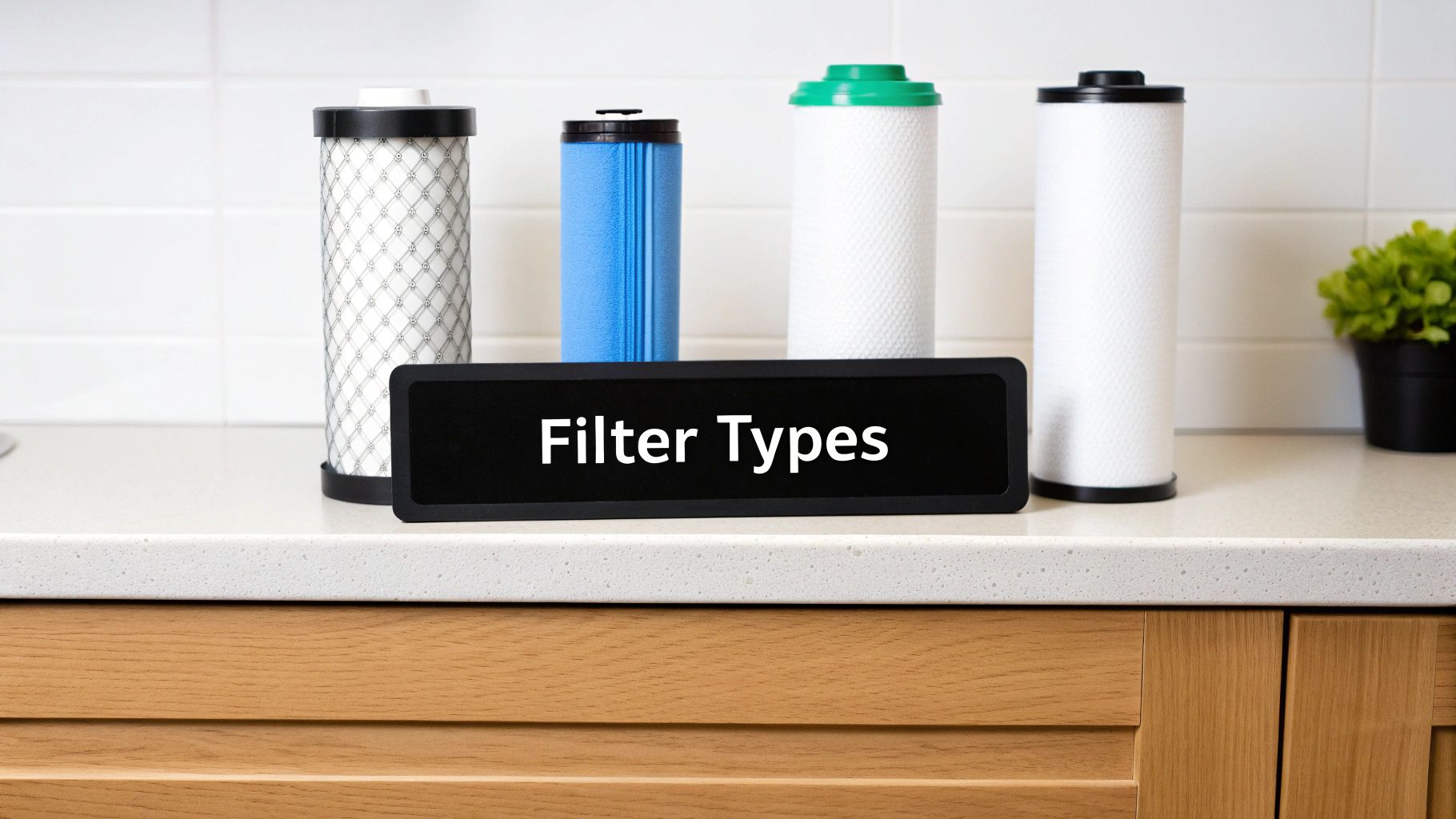
Picking the right water filtration system for restaurants is never a one-size-fits-all deal. It’s really about matching the technology to what you actually do every day—from the water feeding your espresso machine to the supply line for your workhorse dishwasher. If you get this wrong, you're looking at filters that don't work efficiently, surprise maintenance bills, and even damage to your expensive kitchen gear.
The whole process starts with a simple question: what’s in your water? You can't fix a problem you don't understand. Taking this first step lays the groundwork for every other decision, making sure you invest in a system that solves your specific water issues, not one that just takes a wild guess.
Start with a Professional Water Quality Test
Before you even start browsing for hardware, your first move should be a professional water quality test. Think of it as getting a diagnostic report for your restaurant's water. You wouldn't prescribe a treatment without knowing the ailment, right? The same logic absolutely applies here.
This test gives you a detailed breakdown of everything in your local water, pinpointing the exact contaminants you need to deal with. It will measure things like:
- Hardness: The amount of minerals like calcium and magnesium that cause that dreaded limescale buildup.
- Total Dissolved Solids (TDS): A measure of all the inorganic and organic stuff floating around.
- Chlorine and Chloramines: Disinfectants used by the city that can ruin the taste and smell of your food and drinks.
- pH Levels: A reading of your water's acidity or alkalinity.
- Sediment and Turbidity: The presence of physical gunk like sand, silt, or rust.
With this data in hand, you can confidently shop for a system built to tackle the actual problems in your water supply.
Calculate Your Restaurant's Water Demand
Once you know what you need to filter out, the next question is how much water you'll be running through the system. This means figuring out your required flow rate and total daily capacity. These numbers are critical to avoid a bottleneck right in the middle of a dinner rush. A system that can’t keep up is almost as useless as having no system at all.
To get a solid estimate, you need to account for every single tap, nozzle, and machine in your kitchen:
- Ice Machines: Pull the manufacturer’s spec sheet to see water consumption per 100 lbs of ice.
- Beverage Dispensers: Estimate your busiest-hour volume for coffee, tea, and soda.
- Combi Ovens and Steamers: These are thirsty machines; check their technical specs for their water needs.
- Dishwashers: Find the gallons-per-cycle number and multiply it by the number of cycles you run on a packed day.
- Sinks and Pre-rinse Sprayers: Don't forget to factor in all the general use for food prep and cleaning.
Add it all up. This total gives you a clear target for the capacity your filtration system needs to handle, guaranteeing you have a steady stream of clean water when you need it most.
Point-of-Entry vs. Point-of-Use Systems
With your "what" and "how much" figured out, it's time to decide on your filtration strategy. This choice usually boils down to two main approaches: Point-of-Entry (POE) and Point-of-Use (POU) systems.
A Point-of-Entry system is like having a security guard at the main entrance of your building, screening everyone who comes in. In contrast, a Point-of-Use system is like posting individual guards at the doors of specific, high-value rooms.
A POE system gets installed right where the main water line enters your restaurant, treating every drop of water that comes inside. This is the perfect solution for big, building-wide problems like heavy sediment or extremely hard water that wreaks havoc on all your plumbing and equipment.
A POU system, on the other hand, is a much smaller filter installed right before a single piece of equipment. This is a great way to deliver ultra-purified water for very sensitive applications, like an RO system dedicated just to your espresso machine or combi oven. Frankly, many restaurants find a hybrid approach works best—a POE system to handle the big stuff and targeted POU units for specialized gear.
Key Questions to Ask Suppliers
As you start to narrow down your choices, it’s critical to ask the right questions. This helps you see past the sticker price and understand the true cost of owning the system over the long haul. A smart purchase isn't just about the upfront cost; it's about balancing it with ongoing maintenance and reliability.
Before you sign on the dotted line, make sure you ask:
- What are the annual maintenance costs? This should include filter cartridges, membranes, and any necessary service calls.
- What is the filter lifespan and replacement cost? You need to know exactly how often parts need changing and what that will run you.
- Is the system NSF certified? Certification from NSF International is your proof that the system meets strict public health and safety standards.
- What is the warranty on the system and its parts? A solid warranty shows the manufacturer has confidence in their product.
- Do you offer professional installation and support? Proper installation is everything. It ensures the system works correctly and prevents future plumbing nightmares.
By following these steps, you can confidently choose a water filtration system for your restaurant that does more than just improve your menu—it protects your equipment and supports your business for years to come.
The Real-World ROI of Superior Water Filtration
Putting a quality water filtration system for restaurants in place is more than just a technical upgrade or a box to check. It's an investment that pays you back in very real, measurable ways. While there's an upfront cost, the long-term wins in food quality, kitchen efficiency, and your bottom line make a powerful case for it. This isn't just about cleaner water—it’s about building a smarter, more profitable restaurant.
The numbers back this up. The global water purification market is on track to hit an estimated $59.6 billion by 2025, a boom driven by a growing awareness of how water quality directly impacts business. For restaurants, this trend really hits home. Pure water is tied to everything from operational success to customer safety.
Unlocking True Culinary Potential
The first place you’ll see a return is on the plate and in the glass. Think of filtered water as a blank canvas. It lets the true flavors of your ingredients come through without any interference from chlorine, minerals, or other junk.
- Superior Beverages: Coffee and tea are over 98% water. When you pull out the chlorine and excess minerals, that bitter, chemical aftertaste vanishes. What’s left? The rich, aromatic notes of your coffee beans and tea leaves. Fountain drinks taste crisp and clean, just like the manufacturer intended.
- Crystal-Clear Ice: Hard water is the culprit behind cloudy, fast-melting ice that can give drinks a chalky taste. A good filtration system produces hard, crystal-clear cubes that not only look better but chill drinks without watering them down. This instantly elevates every cocktail and soda you serve. You can learn more about why pristine ice matters in our guide to choosing a commercial ice machine.
- Enhanced Food Flavor and Texture: The water you use to boil pasta, steam veggies, or mix dough makes a huge difference. With filtered water, your pasta and bread will have the perfect texture, and vegetables will keep their bright colors and natural taste instead of soaking up off-flavors.
Protecting Your Most Valuable Equipment
Equipment failure is one of the biggest—and most frustrating—financial drains in a commercial kitchen. Limescale, that chalky crud left behind by hard water, is public enemy number one. It quietly wrecks your most expensive machines from the inside out.
A solid filtration system acts like a shield, stopping scale and sediment from building up in your equipment. This has a direct impact on your bottom line by making your critical gear last longer and cutting down on those expensive repair calls.
Preventing scale buildup isn't just maintenance; it's asset protection. By filtering out damaging minerals, you significantly lower the total cost of ownership for every piece of water-fed equipment in your kitchen.
This proactive move means your ice machines, combi ovens, espresso makers, and dishwashers run more efficiently. They use less energy and are far less likely to die on you in the middle of a dinner rush.
Boosting Your Bottom Line Directly
The financial benefits don't stop at avoiding repairs. A water filtration system for restaurants creates a ripple effect of savings that go straight to your profitability. It's the daily operational costs you might not even be thinking about.
For instance, a scale-free dishwasher works better, so you end up using less detergent and rinse aid to get spotless results. In the same way, coffee machines and steamers that aren't fighting scale buildup use less electricity, shaving down your utility bills every single month.
Ultimately, serving top-notch food and drinks builds a reputation for excellence. Customers notice the difference, even if they can't quite put their finger on why. That better taste builds loyalty, drives positive reviews, and gives you a powerful edge that turns first-time guests into regulars. That’s how you drive real, sustainable growth.
Installation and Maintenance Best Practices
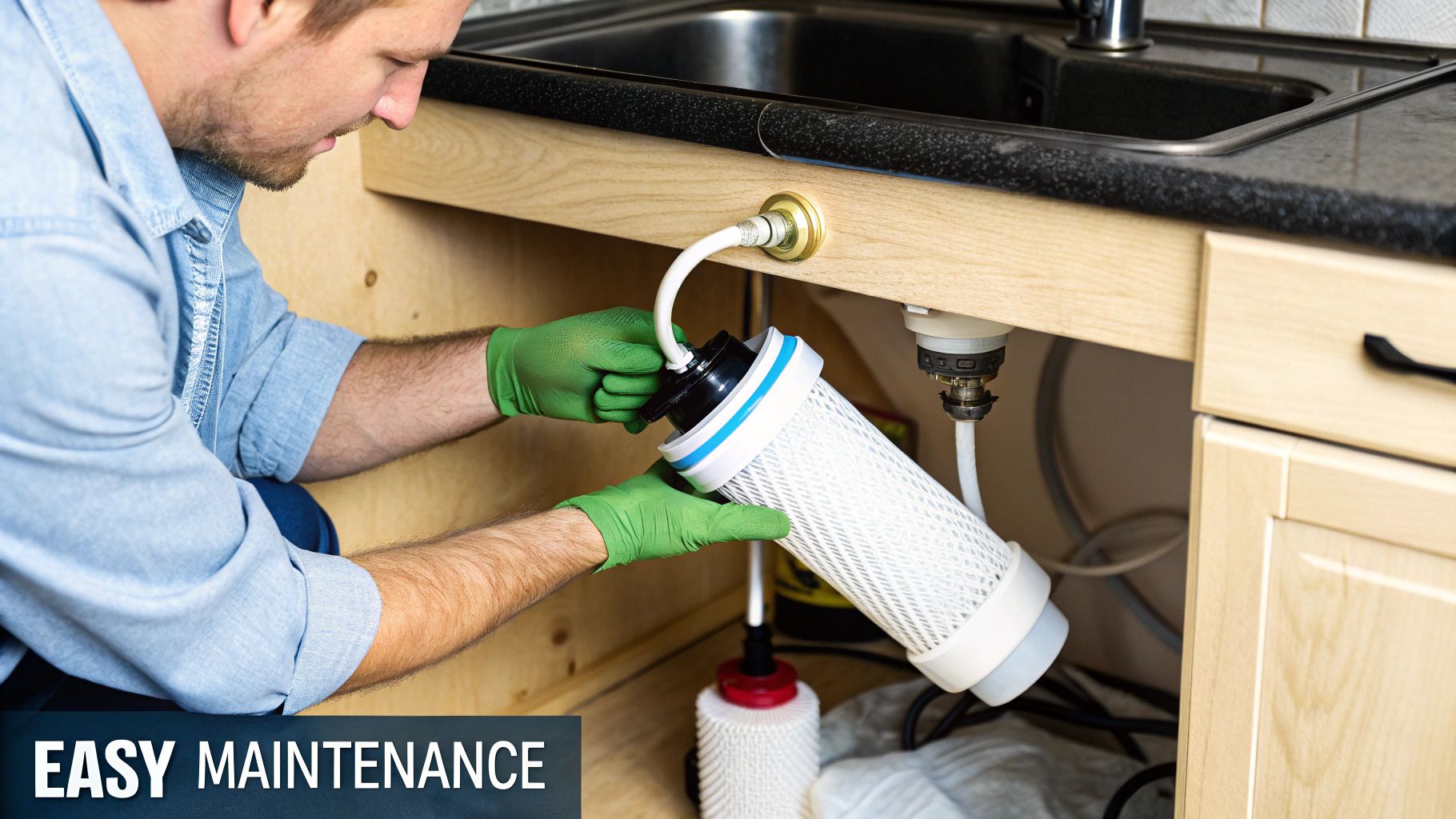
A top-of-the-line water filtration system for restaurants is a fantastic investment, but its real power is only unlocked with proper installation and consistent maintenance. Think of it like this: buying a high-performance sports car and never changing the oil is a recipe for disaster. Sooner or later, performance will drop, and you'll be facing some serious repair bills.
This guide will give you the practical steps to make sure your system runs perfectly for years to come.
First things first: professional installation is an absolute must. It's the only way to be certain the setup complies with local plumbing codes and—just as critically—that you don't accidentally void the manufacturer's warranty. A certified pro will set the correct pressures and tie the system into your plumbing correctly, preventing leaks and guaranteeing peak performance right out of the gate.
Creating a Proactive Maintenance Schedule
Once your system is up and running, proactive care is the name of the game. Waiting around for something to break is just asking for pricey emergency calls and chaotic downtime. A clear, consistent maintenance schedule makes upkeep just another simple kitchen task, not a full-blown crisis.
At the heart of this routine is changing out the filter cartridges. Each filter has a specific job and a different lifespan, so sticking to a schedule is vital for both your water quality and the health of your equipment.
- Sediment Pre-filters: These are your front-line soldiers, catching bigger particles like dirt and rust. They usually need to be replaced every 3-6 months, though this can vary depending on your local water quality.
- Carbon Filters: These are the filters that get rid of chlorine and make your water taste great. Swap them out every 6-12 months. Once they're full, they can't absorb any more contaminants.
- Reverse Osmosis (RO) Membranes: This is the core of an RO system. They're built to last but still need to be replaced every 2-3 years. If you don't, you'll notice a big drop in water quality and flow.
Neglecting filter changes is one of the costliest mistakes a restaurant can make. Clogged filters not only fail to purify water but also cause significant pressure drops, forcing your equipment to work harder and increasing the risk of mechanical failure.
System Sanitization and Spotting Early Warnings
Beyond just changing filters, regular sanitization is key to stopping bacteria and biofilm from building up in the system's housing and lines. This is typically done once a year by a professional and ensures your water stays safe and clean.
It’s also a great idea to train your team on a few simple daily and weekly checks. This can help you catch small issues before they become major headaches. Teach them to look for:
- Pressure Gauge Readings: A big drop in pressure is often the first sign of a clogged filter that needs changing right away.
- Visible Leaks or Drips: Even a tiny drip can lead to water damage and waste over time. Check all the fittings and connections regularly.
- Changes in Water Taste or Odor: If your drinks start tasting "off," that's a tell-tale sign that a filter is used up and needs to be replaced.
Building a routine for your water system is just as crucial as any other task in your kitchen. You can learn more about creating these schedules in our complete guide to commercial kitchen equipment maintenance.
Using a Maintenance Log to Stay on Track
To keep everything straight, a simple maintenance log posted near the filtration unit works wonders. It keeps everyone accountable and makes sure important tasks don't get overlooked during a busy week.
Sample Maintenance Log:
| Task | Frequency | Date Completed | Initials | Notes |
|---|---|---|---|---|
| Check Pressure Gauges | Weekly | |||
| Inspect for Leaks | Weekly | |||
| Change Sediment Filter | Every 3 Months | |||
| Change Carbon Filter | Every 6 Months | |||
| Annual System Sanitization | Annually | Service Provider: | ||
| Replace RO Membrane | Every 2 Years |
By following these best practices, your water filtration system for restaurants will be more than just a piece of equipment. It becomes a reliable asset that protects your other investments and consistently improves the quality of everything you serve.
Common Questions About Restaurant Water Filtration
You've got the basics down, but you probably still have some practical questions about what a water filtration system for restaurants means for your day-to-day. Let's tackle some of the most common things restaurant owners ask.
Think of this as a quick-fire round to clear up any lingering doubts. We’ll get into everything from budget to specific needs for different kitchens, giving you the last few puzzle pieces to make a solid choice.
How Much Should I Expect to Invest?
This is always the first question, and honestly, the answer varies. It really depends on what your restaurant needs. A simple carbon filter for a single coffee machine might only be a few hundred dollars. But a big, high-volume place needing a full point-of-entry reverse osmosis system could be looking at several thousand.
The trick is to see this as an investment, not just another bill. When you add up the long-term savings—less equipment wear-and-tear, lower energy costs, and better-tasting food and drinks—the system often pays for itself. The best way to get a real number is to start with a water quality test and figure out your daily water usage.
The total cost over the life of the system is what really matters, not just the price tag upfront. Make sure any supplier gives you a full breakdown of the unit cost, installation fees, and what you can expect to pay each year for filters and upkeep.
Do Different Cuisines Have Different Water Needs?
Absolutely. Water plays a surprisingly different role depending on what’s on your menu, and that changes what you need from a filter.
- Bakeries and Pizzerias: Water chemistry is a huge deal for dough. Too much chlorine can kill your yeast, and hard water with lots of minerals can make gluten too tight, leading to tough dough. You need a system that can knock down both chlorine and minerals for consistent baking.
- Coffee Shops and Cafes: Here, the big enemy is anything that gets in the way of flavor. Chlorine is a major problem, but so are high levels of Total Dissolved Solids (TDS). Many specialty coffee shops go for reverse osmosis to get a clean, neutral base for the perfect brew.
- Fine Dining and Craft Cocktail Bars: It’s all about perfection. Whether it’s perfectly clear ice that won't water down a top-shelf whiskey or steaming delicate fish without leaving a mineral aftertaste, high-end spots often need advanced filtration like RO to make sure every single detail is flawless.
Can a Filtration System Really Make My Ice Clear?
Yes, and it’s one of the first things you’ll notice. That cloudy look in most ice cubes comes from trapped air bubbles and impurities—mostly minerals from hard water. As the water freezes, all that junk gets pushed to the middle, creating that cloudy center.
A water filtration system for restaurants, especially one that tackles TDS like reverse osmosis, pulls those minerals out before the water even hits the ice machine. You’re left with purer water that freezes into harder, denser, crystal-clear cubes. They look better in the glass and chill drinks more evenly.
How Often Do I Really Need to Change the Filters?
You can't skip this. Sticking to a filter schedule is the only way to keep your water quality high and protect your equipment. The exact timing will depend on the filter type and how much water you use, but here are some solid rules of thumb:
- Sediment Pre-Filters: These catch the bigger particles. Plan on changing them every 3-6 months.
- Activated Carbon Filters: These handle taste and odor. Swap them out every 6-12 months.
- Reverse Osmosis (RO) Membranes: This is the heart of an RO system. These workhorses usually last 2-3 years.
If you let it slide, you're just pushing water through a dirty, useless filter. Not only does your water quality tank, but you’re also making your equipment work way harder, which leads to breakdowns. The easiest way to stay on top of it is to post a simple maintenance chart right next to the system.
Choosing the right equipment is the foundation of an efficient and successful kitchen. At PrepTables.com, we provide the durable, high-quality stainless steel tables, commercial refrigeration, and cooking equipment you need to optimize your workspace for peak performance. Explore our selection and build a kitchen that works as hard as you do. Visit us at https://preptables.com.
